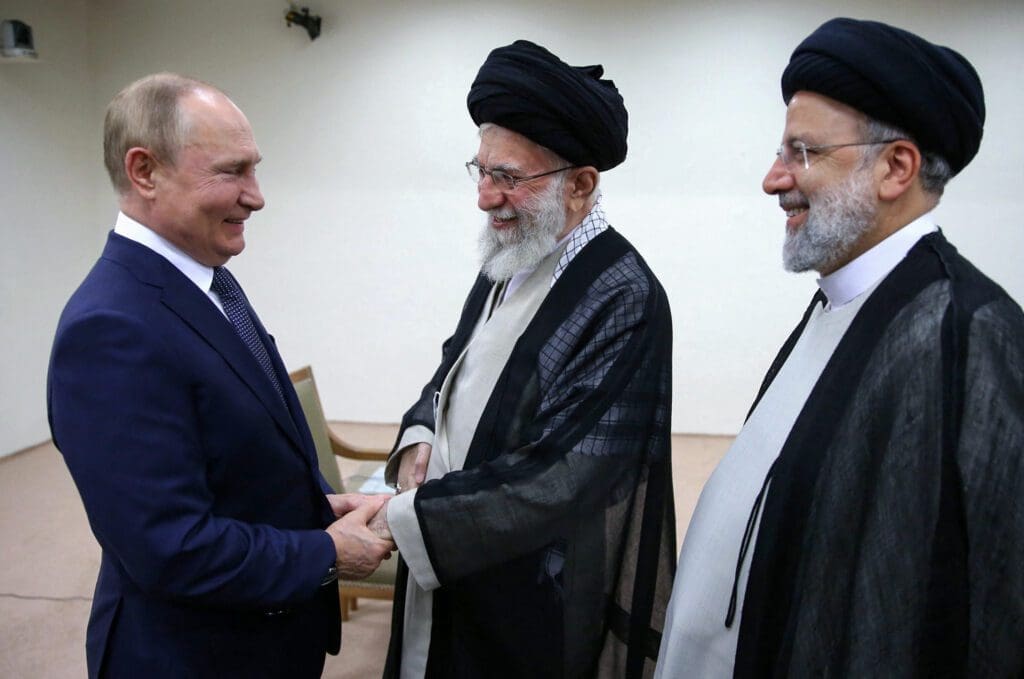
Iran on the Rise? Changing Perceptions and Global Ambitions under Raisi
April 2024
Introduction
President Ebrahim Raisi has placed Iran’s “neighborhood” and “Look East” policies at the center of his foreign relations approach. While these two policy areas have overlapped in the past, they are now much more intertwined after Russia’s war against Ukraine, China’s political engagement in the Gulf region, and Hamas’s attack on Israel on October 7, 2023. These developments have noticeably impacted Iran’s self-perception and foreign policy calculations: Tehran is now fully embracing its eastern outlook, projecting its power more assertively, and actively seeking its revisionist goal of shaping a post-Western order.
The Threefold Success of the ‘Look East’ and ‘Neighborhood’ Policies
The Raisi government’s “neighborhood” and “Look East” policies align with what Supreme Leader Ali Khamenei defined as policy preferences in February 2018. When Donald Trump’s administration was publicly preparing to withdraw the United States (U.S.) from the nuclear agreement formally known as the Joint Comprehensive Plan of Action (JCPOA), Khamenei called on Iranian decision-makers to favor the East over the West and neighboring countries over distant ones.1
In its neighborhood, the Raisi government has largely focused on de-escalation with Arab states of the Gulf, culminating in a normalization agreement with Saudi Arabia in March 2023. Iranian attempts at de-securitization around the Gulf aim at shifting focus to economic integration while alleviating security concerns over Saudi-Israeli normalization. The latter is no longer an immediate threat to Tehran since Hamas carried out its deadliest attack against Israel to date in October 2023, sabotaging the chances of normalization between Riyadh and Tel Aviv for the time being.
Outside its neighborhood in the Gulf, Tehran has mainly focused on revitalizing its “Look East” policy.2 Contrary to past installments, Iran’s current eastern outreach lacks a feasible alternative. As the conflict over Iran’s nuclear program remains unresolved, Tehran continues to be the target not only of a vast regime of U.S. sanctions but also a series of newly imposed sanctions by the European Union (EU) over its brutal crackdown on the nationwide “Women, Life, Freedom” protests in 2022 and 2023. Against this background, balancing an Eastern approach with improved relations with the West is no longer a viable option.
However, Raisi has expanded the “Look East” policy even beyond the scope of what was long deemed expedient among policymakers in Iran. This was evident when Tehran decided to deliver combat and reconnaissance drones to Russia in 2022, thus playing a notable part in Moscow’s war against Ukraine—a decision that drew much criticism at home.3 Yet, for the leadership, Iran’s move from an easily sidelined junior partner to a much-needed supplier of unmanned aerial vehicles (UAVs) has been worth the indirect participation in a war for which Tehran has officially claimed neutrality.4
Iran’s decision to supply UAVs to Russia goes hand-in-hand with a new sense of relevance on the international stage after a series of humiliating setbacks and intelligence failures, including the assassination of General Qassim Soleimani, sabotage of its nuclear sites, and Israel obtaining Iran’s nuclear archive. The sense of increased global significance has also derived from Iran’s accession to the Shanghai Cooperation Organization (SCO) in July 2023—a feat only achieved after an application process that took more than 15 years—and the offer Tehran received and accepted to join the BRICS group formerly comprised of Brazil, Russia, India, China, and South Africa.
While these accomplishments are largely based on the work of preceding presidencies, the Raisi government has been able to claim them as their own, enjoying success on three fronts. First, tensions in the Gulf eased after approaching the brink of war under the previous Iranian government. Second, Iran’s middle power status was expanded on the global stage. Third, Raisi leveraged these successes to bolster domestic support, presenting a much-needed political win to his supporters after nationwide protests shook the pillars of the system for months.
Tehran’s Rising Ambitions for a Post-Western Order
Iran’s foreign policy successes have been achieved during an ongoing critical transitional phase, during which the Islamic Republic is preparing for a post-Khamenei era. Thus, in its own perception, Tehran has displayed significant endurance and near invincibility in the face of external pressure from sanctions and internal unrest. This newfound self-confidence coincides with external political developments that have impacted the Islamic Republic’s role in the international order. Most notably, Russia’s war against Ukraine, China’s shift from an economic actor in the Middle East to a political one, and the brutal attack Israel suffered on October 7 at the hands of Hamas have contributed to Iran’s changing political perceptions.
Against this background, Iran’s eastern and regional policies—once distinct foreign policy areas—have now become much more intertwined. The “Look East” policy used to be driven primarily by economic interests and global geopolitics, while Tehran’s regional relations lacked a substantial economic dimension, centering around immediate security concerns and regional positioning. Today, the two policy areas overlap and even converge in terms of the Islamic Republic’s interest in shaping the international system.
Like other revisionist actors, Iran has rejected a U.S.-dominated order and has shared the expectation of a new multipolar global structure with rising regional powers. It has therefore welcomed the relative decline of the United States as a superpower and envisioned the emergence of a post-Western order. For years, Khamenei has claimed that this new order is already in the making, pointing to four main indicators of this transition.5 These include the increasing transfer of political, economic, cultural, and scientific power from the West to Asia; a decline of the United States, Israel, and Europe; the rise of regional and new global powers; and the expansion of the “resistance front.”6 In September 2023, the Supreme Leader reiterated his assessment that the world was “on the verge of a transformation.”7
Here, Iran has greatly benefitted from the Russian war against Ukraine. The war has widened the global rift between East and West, largely decoupling Russia from the Western sphere for the foreseeable future. Thus, long-held Iranian concerns about Moscow have been alleviated, including the latter’s unreliable support at the United Nations (UN) Security Council or being used as a bargaining chip by Moscow vis-à-vis the United States. Additionally, with China entering the Middle East as a political actor after brokering the agreement with Saudi Arabia, Iran’s “Look East” policy now no longer relies on a vague, long-term vision of a post-Western order. Tehran is already seeing the contours of a new, multipolar world along the lines of global blocs that come with greater opportunities for much closer partnerships in the Eastern hemisphere than the country could have hoped for only a few years ago. This assessment is strengthened by Tehran’s assumptions about the diminishing power of the United States and Europe, as they remain engaged in a costly war in Ukraine, as well as of Israel after the Hamas attacks which were labeled by Khamenei as an “irreparable”8 defeat.
The Iranian leadership has also hailed the October 7 operation as a global demonstration of the strength of the “Axis of Resistance,” which is now further expanded by the active involvement of Ansar Allah in Yemen. The attacks have cemented the Iranian perception of a geopolitical turning point. With the capacity of the “Axis of Resistance” on full display, Iran’s power projection ability has reached an all-time high. Against this background, all four indicators of global transition—as defined by the Supreme Leader—appear to have fallen into place.9 Per Tehran’s assessment, the political developments in Eurasia and the Middle East will allow Iran to move beyond loosely associated alliances to create a much tighter net of structures, common interests, and dependencies in its neighborhood and wider Asia.
Stars Aligning for a Rising Iran?
As the Iranian leadership sees the stars aligning for its geopolitical rise and the emergence of a post-Western order, it remains on a slippery slope. Ironically, while the resistance front has never felt more powerful, it has never been more vulnerable. An all-out war of the entire “Axis of Resistance” against Israel and its allies might trigger a devastating blow to at least part of the Axis, thus markedly weakening Iran’s biggest security asset in the region. Accordingly, Tehran appeared to tread cautiously after October 7, denying any involvement in planning the Hamas operation, but not without warning that another front against Israel remained a real possibility.10
If Iran were to directly engage in a military conflict with Israel, this would significantly impact its “Look East” approach as well. Neither Russia nor China wants to be dragged into a region-wide conflagration; further escalation could deter them from closer relations with Tehran down the line. With Iran becoming a massive security liability for Moscow and Beijing, Tehran’s ambitions of playing a shaping role within a rising Asia may diminish rapidly. Iran’s tentative normalization with Gulf states may suffer as well. As Arab states of the Gulf have resumed diplomatic ties with Iran—in anticipation of decreased tensions and lower risks of military confrontation—they are not eager to see Tehran further foment regional tension.
Even without a full-scale military conflict, Iranian expectations toward the East will likely be disappointed. Tehran’s foreign policy approach comes with numerous shortcomings and limitations, including the possibility of domestic backlash, economic constraints due to U.S. secondary sanctions, and a general misconception of Western decline.11 As Iran has been turning its back on the West, its “Look East” policy has already been suffering, strongly limiting Tehran’s opportunities to expand economic and financial relations with its Eastern partners.12 It has become clear that even countries such as China or India cannot fully escape pressure to comply with U.S. sanctions. With the Western sanctions regime firmly in place, Iran’s “Look East” policy remains obstructed.
Furthermore, although actors such as Russia or China may share Iran’s discontent with the current world order, this does not constitute any consensus on what a new one should look like when it comes to international structures, institutions, or norms. Notwithstanding any differences, Iran has sought closer partnerships with these states in the past based on pragmatic considerations. With the changing political environment in Eurasia, Tehran has shown a willingness to move beyond temporary tactical alliances toward strategic cooperation. At the same time, the Iranian leadership has either ignored or readily dismissed domestic criticism regarding the actual political costs of strategic alliances and their implications for national sovereignty.
Given the numerous challenges and obstacles still in place, Iran’s geopolitical rise in a new world order is far from certain. Yet, from Tehran’s perspective, all pieces appear to be falling into place, based on a self-perception of unprecedented strength and an ideal geopolitical turning point. Russia’s war in Ukraine, China’s mediation efforts in the Gulf, and the all-out attack of Hamas on Israel have shifted its long-standing vision for a future global order to a near-term goal. As Iran is pushing for a revision of the international system, it is going to synchronize its “Look East” and regional policies more closely. As such, Tehran is likely to be much more assertive in its revisionist agenda and less risk-averse with regard to a broader confrontation with Israel or the United States.


